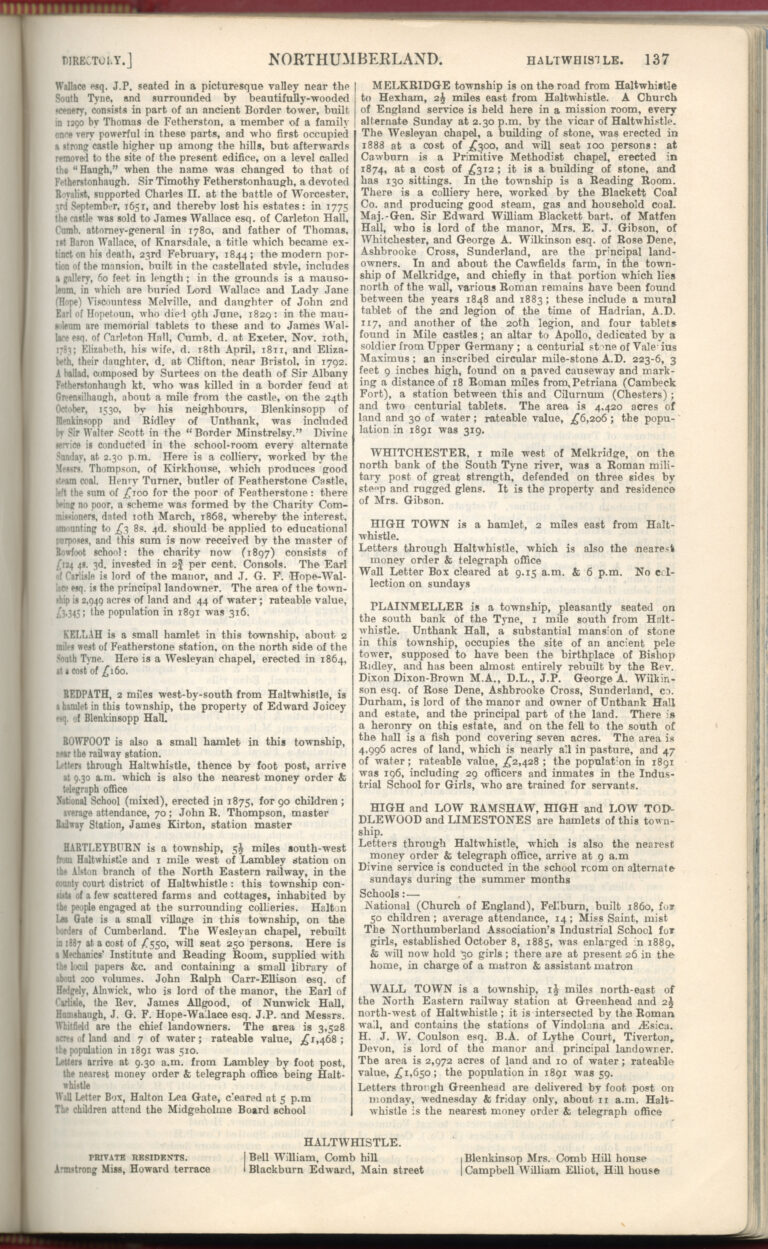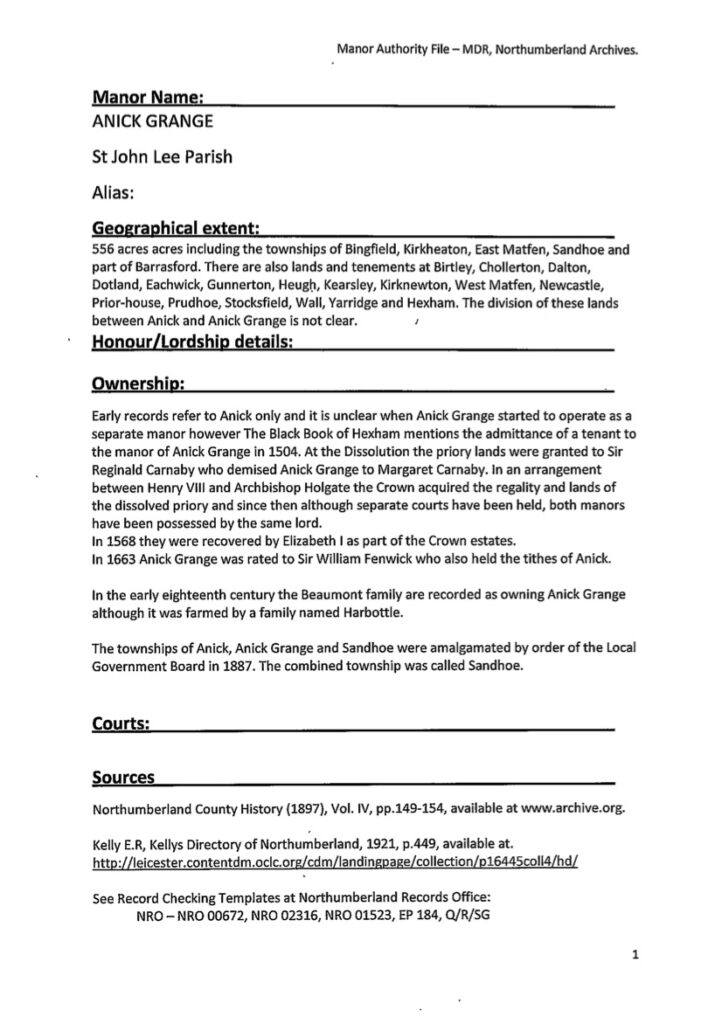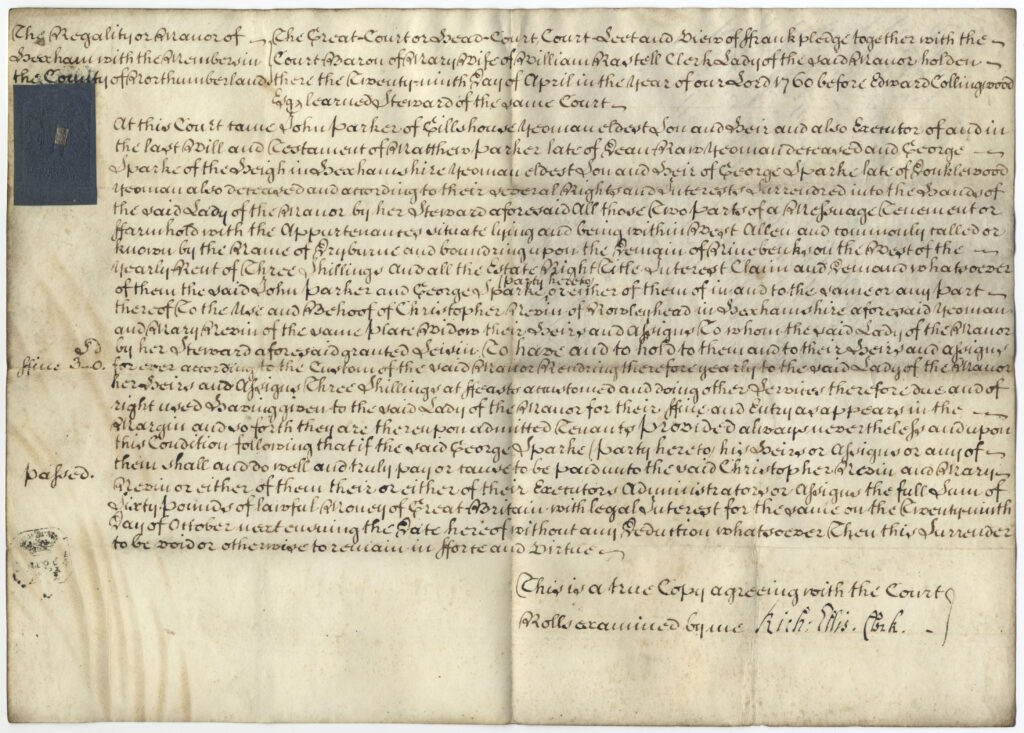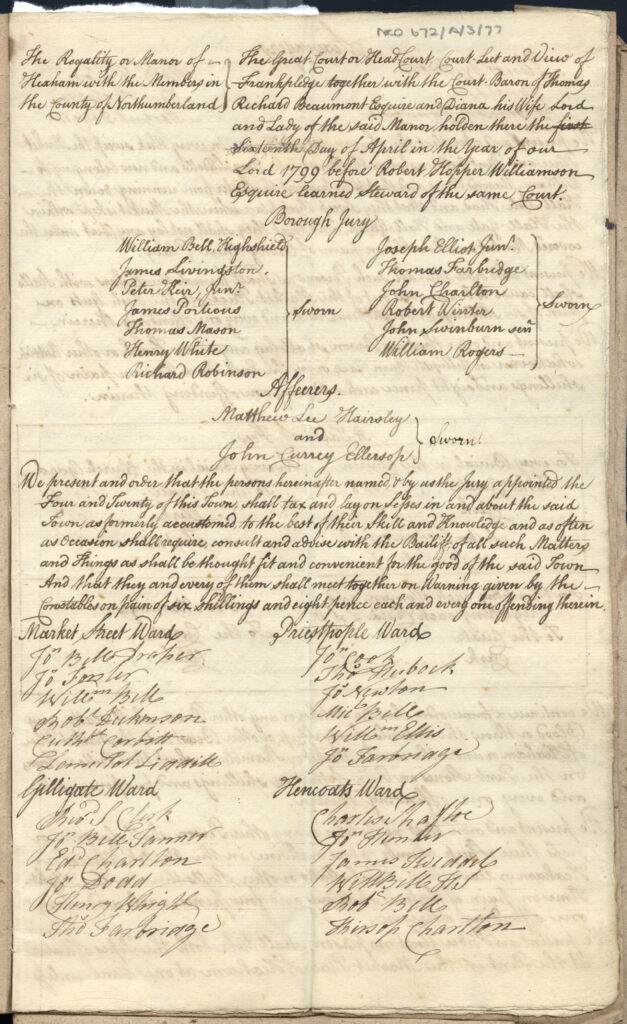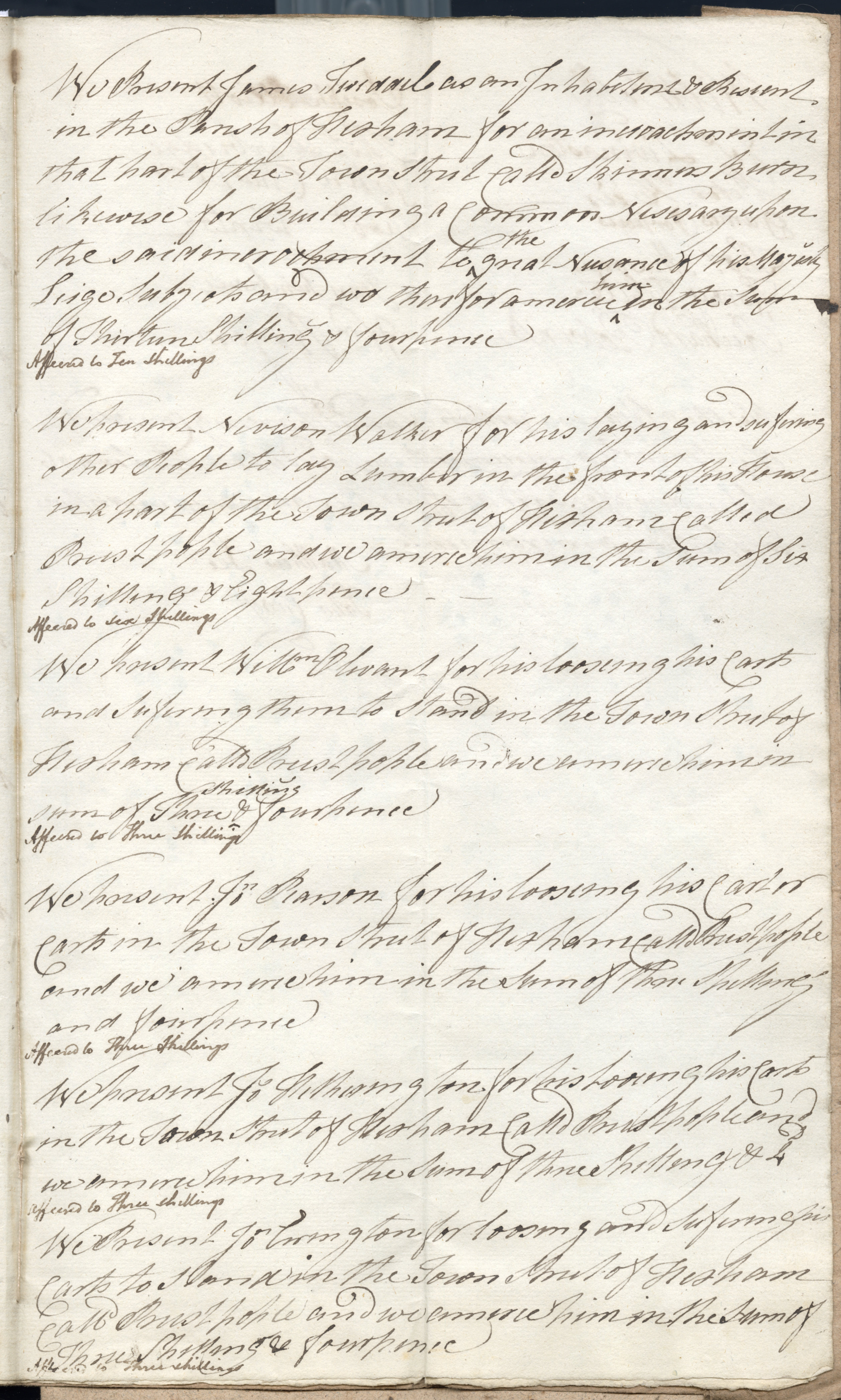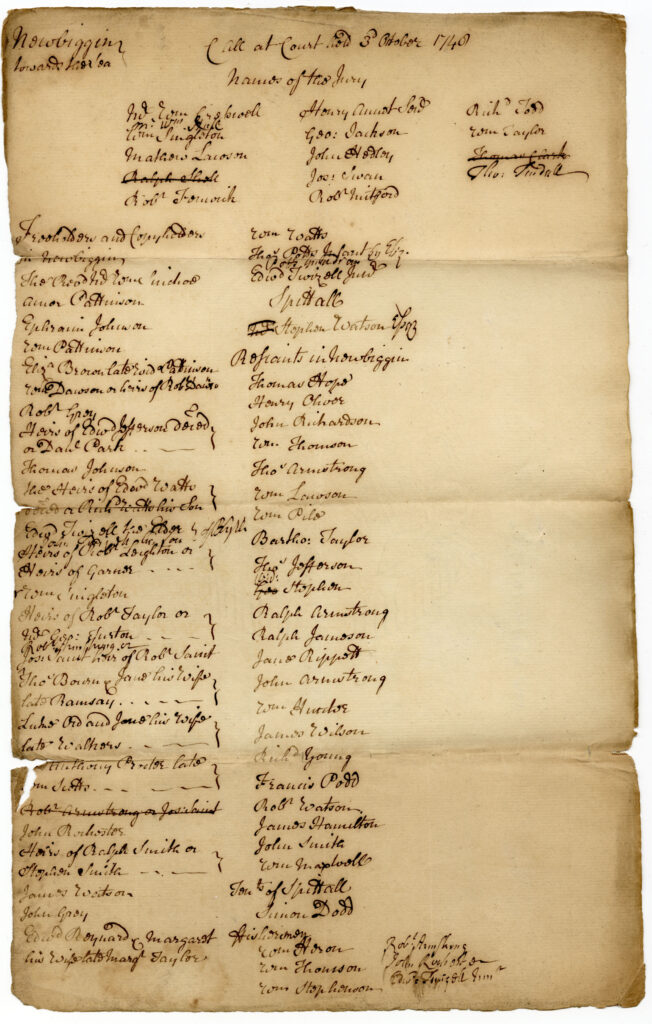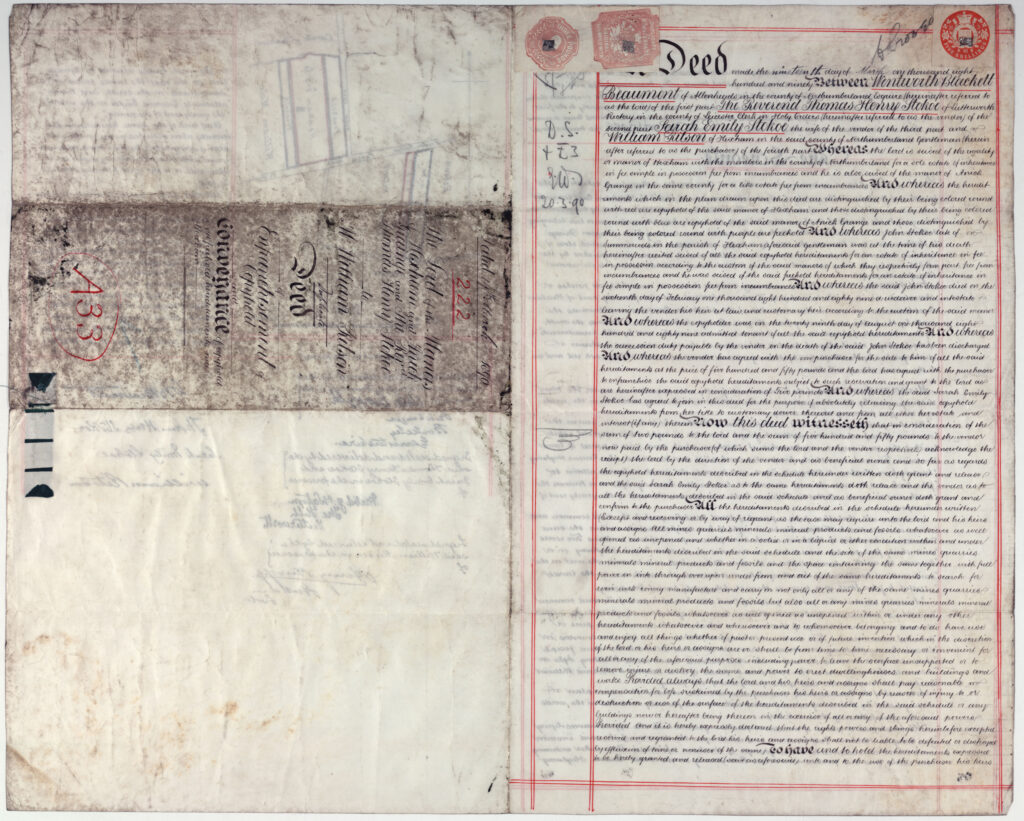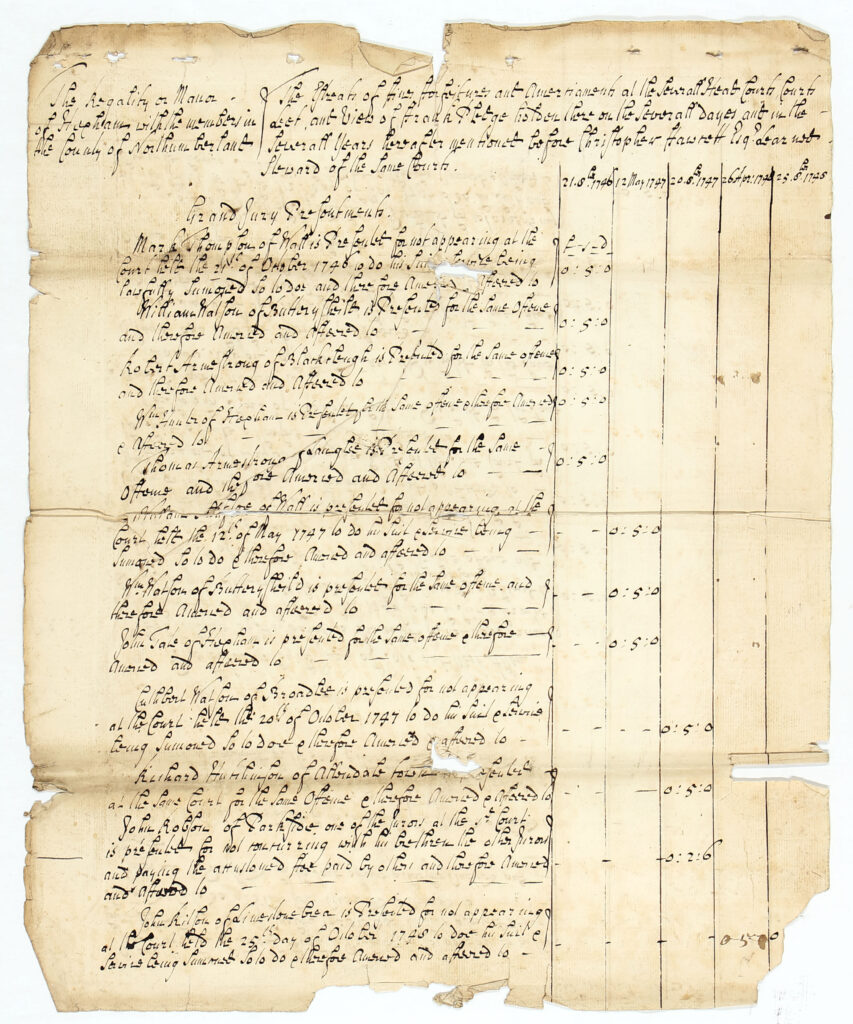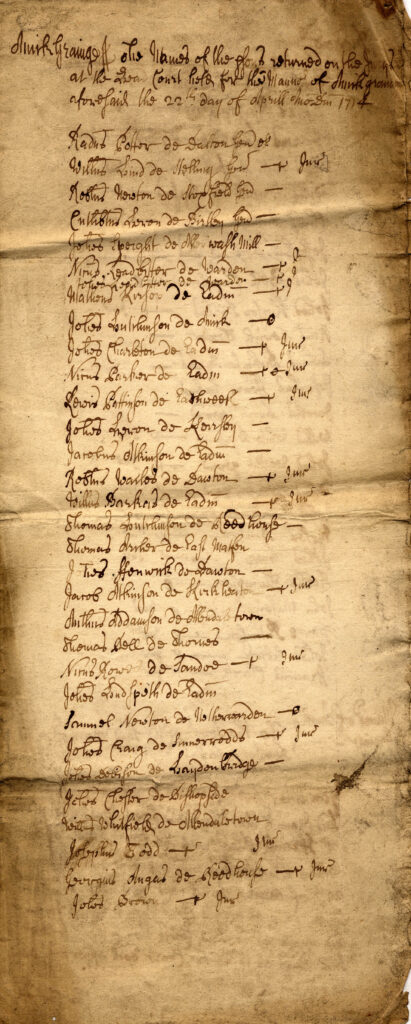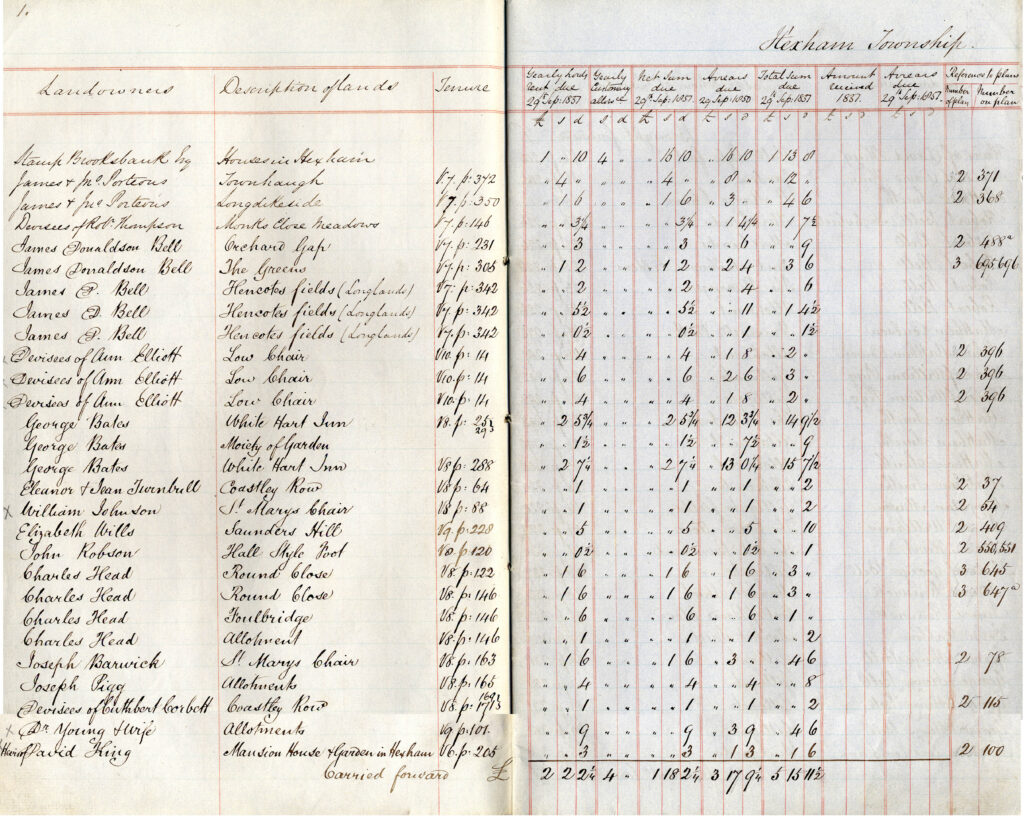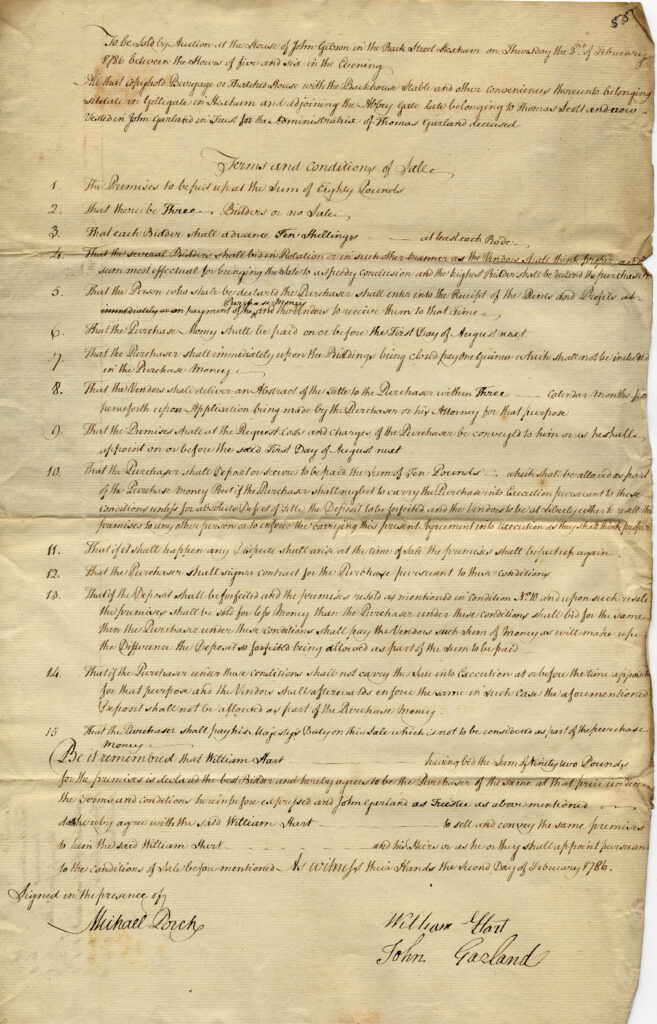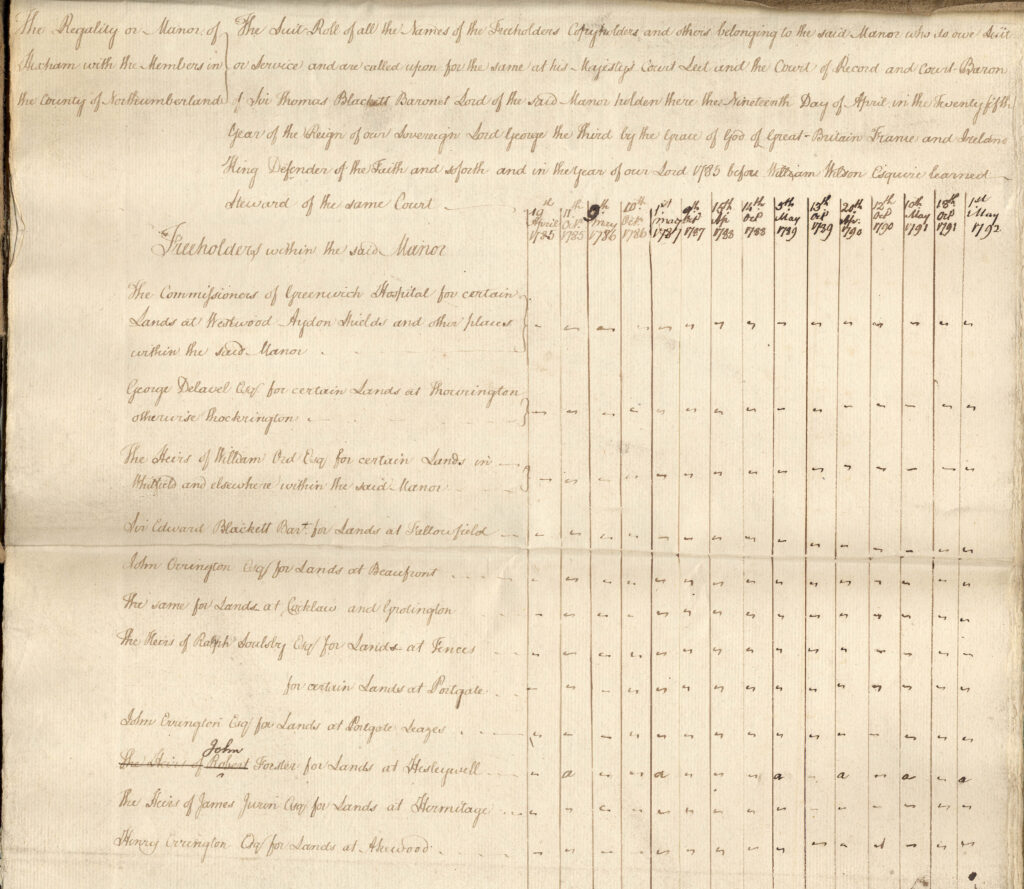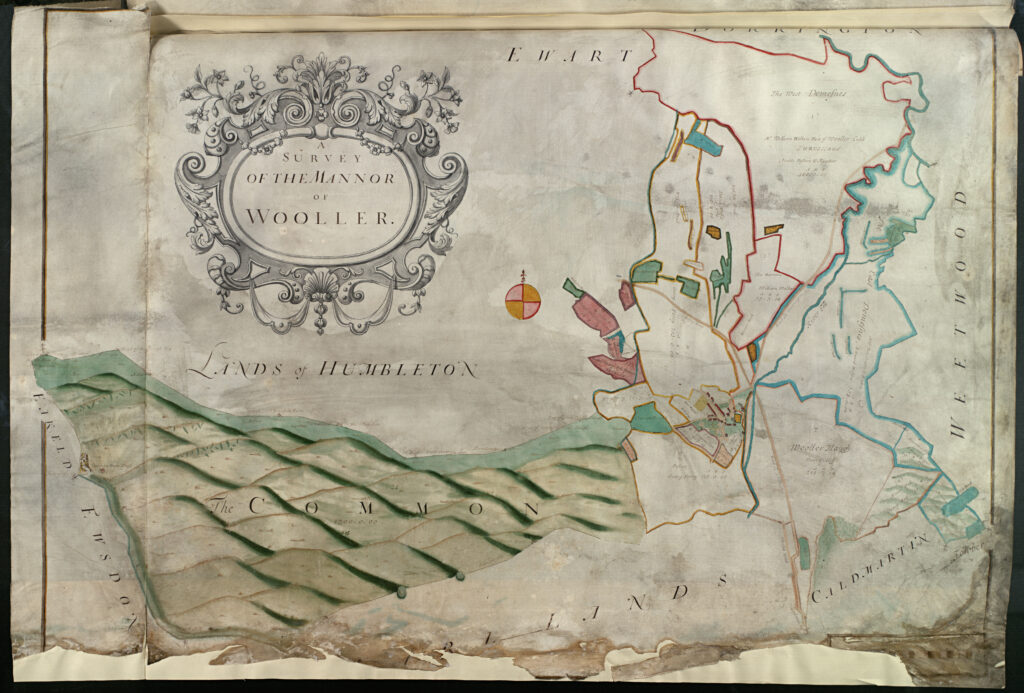MANORIAL RECORDS
Historically, many areas of Northumberland formed part of a manor. When researching the history of an older property you should consider whether this was the case. Looking at trade directories or the relevant volume of the Northumberland County History are good starting points to discover whether there was a manor in the geographical area that you are researching.
What is a Manor?
A manor was a unit of land with the landowner being the Lord of the Manor. The Lord of the Manor had the right to hold a manorial court that exercised jurisdiction over the tenants of the manor. There were two main types of manorial court, the Court Baron and the Court Leet.
The Court Baron dealt with changes of tenancy on the manor, infringements of the customs (rules) of the manor, disputes regarding the use of land within the manor and minor civil pleas.
The Court Leet dealt with breaches of the peace and public order, other minor ‘criminal’ offences within the manor and issues regarding the sale of goods etc within the manor. Some of these functions were picked up by Local Authorities in the 19th century.
Forms of Manorial Tenancy
There were two main forms of manorial tenancy:
- Freehold – usually related to the more valuable properties within the manor.
- Copyhold or customary – this was a form of tenancy was unique to a manor and meant that the property was held according to the custom of the manor. The majority of manorial properties were held as copyhold. If you find reference to a property being a copyhold it is a clear indication that it was manorial property. Copyhold existed until 1922 when the Law of Property Act abolished copyhold tenure.
Locating Records
Details of extant manorial records in both public and private custody are recorded in the Manorial Documents Register (MDR). The Register can be located on The National Archives website – Manorial Documents Register (nationalarchives.gov.uk). A useful guide to using the MDR can be found here Manorial documents and lordships and how to use the Manorial Documents Register – The National Archives. Northumberland Archives completed the revision of the Northumberland section of the MDR in 2018. The included material held in our care and in private hands, notably records held by Northumberland Estates that owned more than 40% of Northumberland manors.
As part of the MDR revision we compiled a list of all proven Northumberland Manors. This can here found here. We also produced a Manor Authority File for each of the proven manors. The files provide information about the extent and situation of the manor. Here is a sample Manor Authority file for the manor of Anick Grange.
Records Created by the Manor
Survival of manorial records is patchy. There are no known extant records for some Northumberland manors and for others few records have survived. Using the Manorial Documents Register (nationalarchives.gov.uk) is the most straightforward means of discovering which records survive. It is important to understand that the register only records the existence of certain classes of record. It is therefore advisable to use the register in conjunction with Northumberland Archives catalogue. The records of Hexham Manor have survived well and are the most extensive collection of manorial records held by Northumberland Archives.
Researchers should look for the following classes of manorial records:
- Admissions (or Admittances)
- Borough Books
- Call Rolls/Books
- Court Rolls
- Deeds of Enfranchisement
- Estreat Rolls
- Jury Lists
- Rentals
- Steward’s Papers
- Suit Rolls
- Surveys
Admissions (or Admittances)
Copyhold tenants were granted possession of a property by a process known as admission (or admittance). This took place after the previous tenant had surrendered the property. The formal document recording this process is known as admission/admittance or surrender and admission/admittance. This example of 29 April 1760 records relates to the surrender and admission to property called Dryburne, West Allen.
Give it a go
Try to decipher the information in this document and put together a brief summary of what can be learned from it.
For guidance on reading handwritten documents please see our Decoding Manuscripts module.
NRO 672/A/7/87 – SUMMARY
Manor: Manor of Hexham
Date: 29 April 1760
Parties:
- John Parker, yeoman, of Gillshouse, eldest son, heir and executor of the last will and testament of Matthew Parker deceased, yeoman, of Dean Raw.
- George Sparke, yeoman, of the Heigh, Hexhamshire, eldest son of George Sparke, deceased, yeoman.
- Christopher Nevin, yeoman, of Rowleyhead, Hexhamshire, and Mary Nevin, widow, of the same place.
Parties 1 & 2 surrender the property. Party 3 is admitted to the property.
Property: two parts of a messuage, tenement or farmhold with appurtenances situate lying and being within West Allen called Dryburne
Answer goes here.
Answer 1
Answer 2
Answer 3
Borough Books
The records of Hexham Manor include a series of Borough Books, 1634-1872. These were a separate series of records that were kept and appear to record some of the business of the Court Leet as well as setting out some of the rules or customs relating to the governance of the town. In Northumberland, these records are unique to Hexham Manor. The Books don’t include references to property transactions but may include references to people who lived in the property being researched.
The first image is an example from April 1799 (ref: NRO 00672/A/3/77) lists the members of the Borough Jury, the affeerers (men administering the fines set by the court) and the Four and Twenty (vestry).
The second image is a page from the same volume lists presentments – cases heard before the court.
Court Rolls
The court roll lists the business of each court.
This example is the first page of the Tweedmouth Manor Court Roll of 14 October 1658. The page lists the jurymen and then the presentments – details of cases heard at the court. The cases listed on this page relate to instances of affray and abusing the constables. It may be possible to find a case involving a former resident of a property that you are researching in a court roll. The Hexham court rolls cover the period 1559-1726 (ref: NRO 00672/A/1/A).
Deeds of Enfranchisement
Copyhold tenure was extinguished under The Law of Property Act of 1922. This led to the conversion of copyhold tenure to leasehold. In practice some conversion of the tenure took place in advance of the 1922 Act. Deeds of enfranchisement record the conversion of copyhold tenure to freehold. In this example dated 19 March 1890, land formerly part of Hexham East Common and held by William Ritson, gentleman, of Hexham, was converted from copyhold to freehold tenure.
Answer goes here.
Answer 1
Answer 2
Answer 3
Give it a go
Try to decipher the information in this document and put together a brief summary of what can be learned from it.
For guidance on reading handwritten documents please see our Decoding Manuscripts module.
NRO 672/A/27/4/122 SUMMARY
Date: 19 March 1890
Parties:
- Wentworth Blackett Beaumont, of Allenheads, Lord of the Manor.
- Rev. Thomas Henry Stokoe, Clerk in Holy Orders, of Lutterworth Rectory, Leicestershire.
- Sarah Emily Stokoe, wife of Rev. Thomas Henry Stokoe, Clerk in Holy Orders, of Lutterworth Rectory, Leicestershire.
- William Ritson, gentleman, of Hexham, Northumberland.
2 is selling the property to 4.
Other Persons Referenced:
John Stokoe, gentleman, deceased, of Summerods in the parish of Hexham, Northumberland. Died 16 February 1889. John Stokoe died intestate.
Property:
- A close of land containing 4 acres and 3 perches situate in the township of Hexham formerly part of Hexham East Common.
- A close of land containing 1 acre, 2 roods and 31 perches situate in the township of Hexham formerly part of Hexham East Common.
Sale price of property: £550
Answer goes here.
Answer 1
Answer 2
Answer 3
Estreat Rolls
Estreat rolls record the fines issued by the manor court. The rolls don’t refer to property transactions but it is possible to find references to tenants of manorial properties that were fined by the court. This example of 1746-1748 (ref: NRO 00672/A/12/1) relates to the Manor of Hexham.
Steward’s Papers
Manorial collections sometimes include steward’s papers. The steward was the chief officer of the manor. It is worth checking any lists of steward’s papers for other items of potential interest. This example from the records of the Manor of Hexham is an auction sale notice of thatched house with backhouse stable and other buildings in Gilesgate, Hexham.
Surveys
A survey is a record of the lands held by the Lord of the Manor. These can take the form of plans or textual documents or both. This example from “A Survey of Severall Lands and Mannors Being the Estate of The Right Honourable Charles Ossulston, In The County of Northumberland. By Henry Pratt. Anno 1711″ (ref: NRO 04206/f.20) is a plan of the Mannor of Wark, Northumberland.
Everyday Life in a Northumberland Manor
Northumberland Archives is currently (2023) running a project supported by National Lottery Heritage Fund to digitise and transcribe some of the manorial records in our care. The transcriptions and digital images will be made available on our website – Everyday Life In A Northumbrian Manor – Northumberland Archives.
Reading List
M.Ellis Using Manorial Records (PRO 1994)
Websites
The following websites provide useful information about manorial records:
Cumbria Manorial Records project – Cumbrian Manorial Records – Homepage (lancaster.ac.uk)
University of Nottingham – Introduction to manorial records – The University of Nottingham


